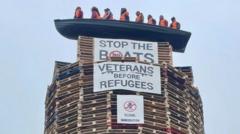Why Are Parties Outraged Over Refugee Bonfire Effigies?

Understanding the Controversy Surrounding the Moygashel Bonfire Effigy
In recent days, a bonfire in Moygashel, County Tyrone, has become a focal point of controversy due to the placement of an effigy depicting refugees in a small boat atop the fire. This incident has sparked intense debate among local political leaders, community members, and human rights advocates. As the bonfire is set to be lit on July 11—a date historically significant for unionist celebrations—the implications of this effigy raise critical questions about cultural expression, tolerance, and the ongoing refugee crisis. This article delves into the reactions from various political factions, the significance of the bonfire tradition, and the broader societal implications of such displays.
The Background of the Moygashel Bonfire Tradition
The tradition of lighting bonfires in Northern Ireland, particularly in unionist areas, dates back centuries. Traditionally, these fires are lit to commemorate the arrival of King William III in 1690, marking a significant moment in Irish and British history. The bonfires are often accompanied by parades and other cultural festivities, serving as a means for communities to celebrate their heritage.
However, the cultural significance of these bonfires has increasingly come under scrutiny, particularly when elements perceived as divisive or hateful are incorporated. The Moygashel bonfire has become a case study in how cultural celebrations can intersect with current social issues, such as immigration and national identity.
The Effigy and its Implications
The effigy in question—a small boat with figures inside, placed atop a banner reading "stop the boats" and "veterans before refugees"—has been described by many as a clear incitement to hatred. Critics argue that it not only dehumanizes refugees but also reflects a growing trend of far-right sentiment in various communities.
Colm Gildernew, a representative from Sinn Féin, condemned the effigy as a "vile and a deplorable act," going so far as to label it a hate crime. He emphasized the necessity for immediate action from the Police Service of Northern Ireland (PSNI) to remove the offensive display. Similar sentiments were echoed by members of the Ulster Unionist Party (UUP) and other political figures, all urging for the effigy to be dismantled.
Political Responses and Community Reactions
The Democratic Unionist Party (DUP) has stated that the placement of flags or effigies on bonfires is not part of their tradition and should not occur. They emphasized that the bonfires should be positive cultural celebrations rather than platforms for divisive rhetoric. UUP leader Mike Nesbitt described the effigy as "sickening" and too far removed from what should be a celebration of culture.
In contrast, community figures and organizations, including Amnesty International and the North West Migrants' Forum, have expressed outrage over the incident. They argue that such displays only serve to incite fear and perpetuate negative stereotypes about refugees and asylum seekers. Gaelle Gormley from North West Migrants' Forum pointed out the fear this display incites among asylum seekers and refugees, calling for better education on the topic.
The Dangers of Inciting Hate
The controversy surrounding the Moygashel bonfire effigy highlights a more extensive issue: the dangers of hate speech and its impact on society. Effigies, particularly those that dehumanize vulnerable populations, can exacerbate societal divides and foster an environment of intolerance.
- Dehumanization: Effigies can reduce complex human experiences to caricatures, stripping individuals of their humanity and dignity.
- Incitement to Violence: Such displays can incite violence against marginalized groups, as they may embolden individuals with extremist views.
- Polarization: Incidents like these can deepen divisions within communities, making it harder for diverse groups to coexist peacefully.
The Role of Law Enforcement
In response to the growing outcry, the PSNI has stated they are aware of the effigy and are conducting inquiries. The role of law enforcement in situations like this is crucial, as they are tasked with maintaining public order and protecting vulnerable populations from hate-driven actions.
However, the effectiveness of law enforcement can often be measured by their ability to engage with communities proactively, fostering dialogue around sensitive issues like immigration and cultural identity. Understanding the roots of such displays may help prevent similar incidents in the future.
Addressing the Refugee Crisis
The Moygashel bonfire incident also serves as a reminder of the broader challenges surrounding the refugee crisis. As millions of individuals worldwide are forced to flee their homes due to war, persecution, and poverty, societies must grapple with how to respond to these crises compassionately.
Humanitarian organizations advocate for a more nuanced understanding of refugees and asylum seekers. By emphasizing their stories, struggles, and contributions, communities can foster empathy and understanding rather than fear and resentment.
Conclusion
The placing of an effigy of refugees on a bonfire in Moygashel has ignited a significant and necessary debate about cultural expression, tolerance, and the treatment of vulnerable populations. As political leaders and community members react to this incident, it is essential to consider the broader implications of such displays and work towards a more inclusive society.
As we reflect on this situation, let us ask ourselves how we can contribute to a more understanding and compassionate community. What steps can we take to ensure that expressions of culture do not come at the expense of human dignity? The dialogue surrounding this issue continues, highlighting the need for empathy and awareness in our increasingly complex world.
FAQs
What was the effigy placed on the bonfire in Moygashel?
The effigy depicted refugees in a small boat, placed atop a banner that read "stop the boats" and "veterans before refugees."
What reactions have political leaders had to the effigy?
Political leaders, including members of the DUP, Sinn Féin, and UUP, have condemned the effigy, labeling it hate speech and calling for its removal.
What is the historical significance of the bonfire tradition in Northern Ireland?
The bonfire tradition in Northern Ireland commemorates the arrival of King William III in 1690 and has been a part of cultural celebrations in unionist communities.
What are the potential dangers of hate speech and dehumanization?
Hate speech and dehumanization can lead to violence, societal polarization, and a culture of intolerance, making it essential for communities to address these issues constructively.
As we navigate these complex social dynamics, how do you see the role of cultural celebrations evolving in a diverse society? #CulturalAwareness #RefugeeRights #CommunityUnity
Published: 2025-07-09 22:59:14 | Category: technology


